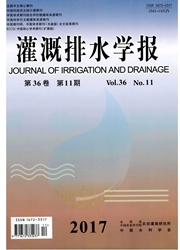

 中文摘要:
中文摘要:
通过盆栽试验,对不同水肥争件下冬小麦的产量、品质和氮肥的表观去向进行了研究。结果表明,适宜供水、轻度亏缺和重度亏缺水分处理下产量达到最高点的氮肥施用量分别为345、274和201kg/hm^2,籽粒粗蛋白达到最大的施氮量分别为414、386和350kg/hm^2;氮肥效益的发挥与水分状况密切相关,水分严重亏缺时,氮肥的利用率低,残留和损失量较高;为获得较大的经济效益,用二次方程表述氮肥施用量和冬小麦产出的关系,获得不同水分条件下氮肥的经济施用量分别为308、234和147kg/hm^2。
 英文摘要:
英文摘要:
Pot experiments were conducted in 2006 to study the effects of the coupling of water-fertilizer on winter wheat grain yield and its quality and apparent N uses. The results showed that under the different water levels of W1, W2 and W3, the N application rate for maximum grain yield was 345, 274 and 201 kg/hm^2, and that for maximum grain crude protein content was 414, 386 and 350 kg/hm^2. Nitrogen production efficiency was greatly related to moisture condition. At low water supplying levels (W3), the lowest N application rate and the highest N residual were obtained. Quadratic equation was used to describe the relation between the N application rate and the winter wheat grain yield, and the maximum economic rate of N fertilizer application was 308, 234 and 147 kg/hm^2.
 同期刊论文项目
同期刊论文项目
 同项目期刊论文
同项目期刊论文
 期刊信息
期刊信息
